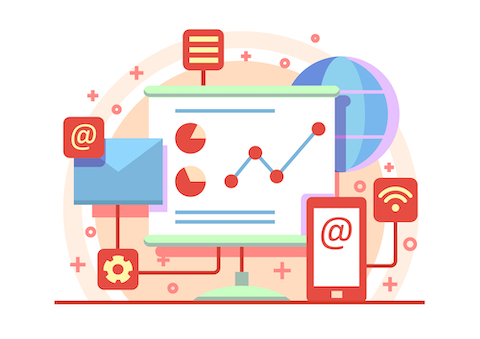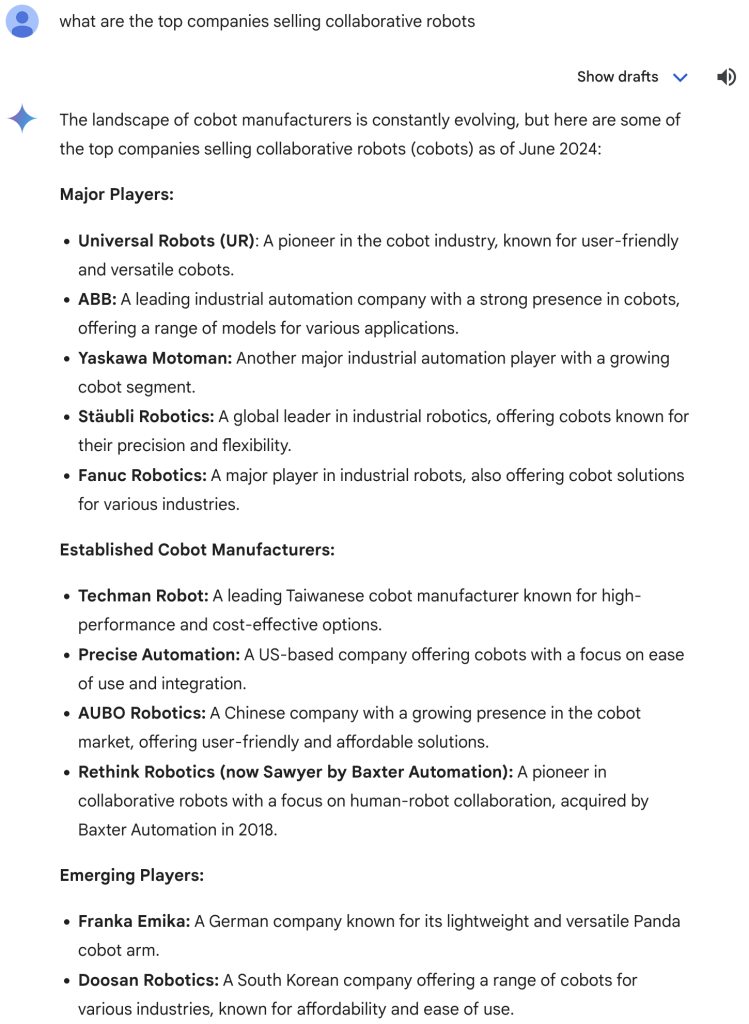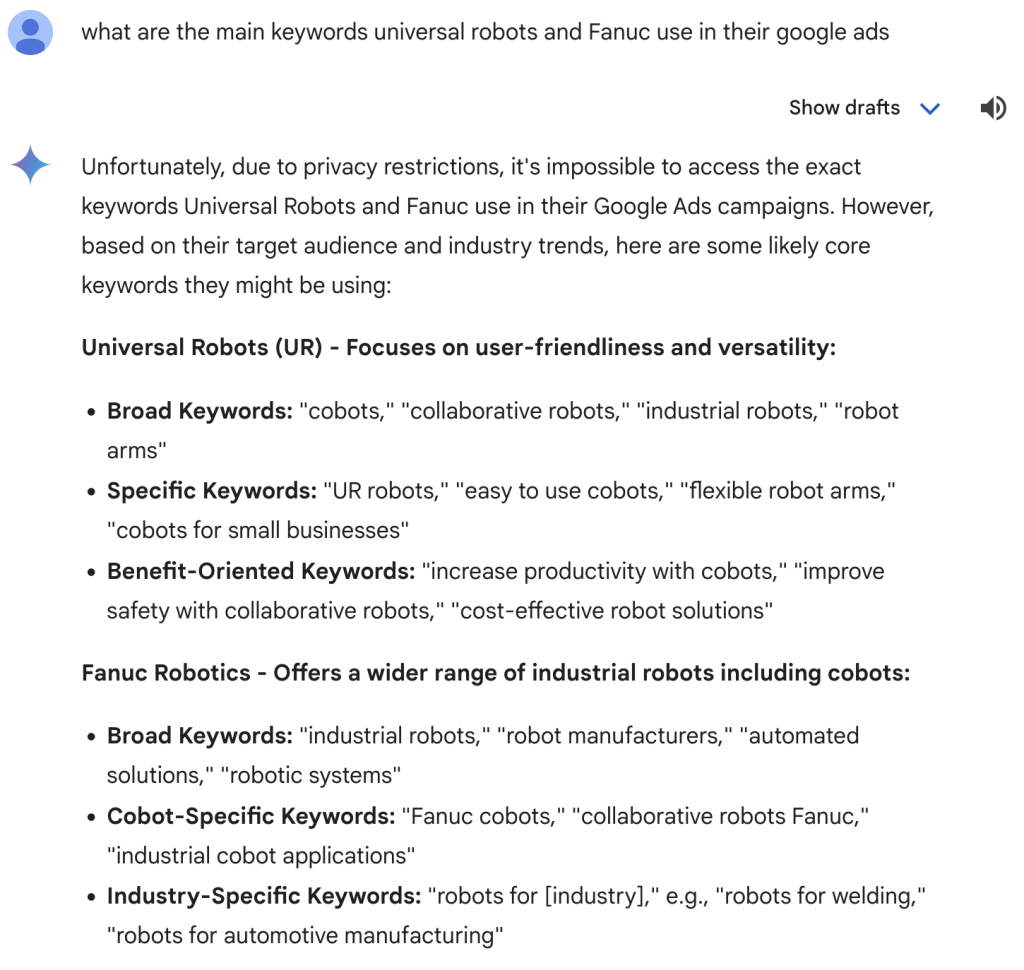AI and Google Ads has been a hot topic for the last year or so.
Because the topic has been discussed so much, some people are under the impression that the Google Ads platform is nothing but AI. You can flick a switch, and your Google Ads program basically runs itself.
There’s no denying that AI is an important part of Google Ads—and has been for years. You can see it at work in many Google Ads features, from automated bidding to Performance Max campaigns.
But this doesn’t mean that you can leave everything to the robots. If you left your Google Ads program to its own devices, you’d quickly burn through your budget and probably not be any closer to your goals.
What is new and exciting about AI for advertisers is the opportunity it presents outside of the Google Ads platform. Most of us are just starting to use it to find new efficiencies, support creativity, and overcome roadblocks.
Here are some of the ways we’ve been testing and using AI in our Google advertising—and what we’ve learned along the way.

AI for creating ad images
Sometimes, clients are slow to get us the assets we need for their advertising, such as product images.
When this happened with a client recently, one of my team members used AI to create product images to see if they could generate something good enough for us to use (with the client’s approval, of course).
The experiment accelerated the process of getting us the images we needed, but not in the way we expected.
Let’s look at the pros and cons of our experiment, starting with the cons.
Cons
You likely won’t be surprised to learn that the client identified problems with the images the AI tool generated.
Below are three of the AI-generated images. Can you spot some of the issues?

Image 1

Image 2

Image 3
The most obvious issue is branding.
The equipment in the first image does not have a name or logo, as it would in real life. The equipment in the second and third images has some sort of nonsensical brand name on it.
If you’re an expert in this type of equipment (as our client is), you may have also noticed that:
- Some of the images depict European models that no one uses in the U.S. (our client is U.S.-based)
- The arm on the combine harvester is attached to the wrong side (image 3).
Pros
Given these shortcomings, you may think the experiment was a failure, but it wasn’t.
Going through this process accomplished three things:
- Gave the client examples of what we needed
- Spurred the client into action to get us real images
- Helped my team and I better understand our client’s products
Not incidentally, it was also a great learning experience for my team, confirming that AI-generated images are probably not usable for advertising purposes (yet!).
AI for creating text ads
Creating copy for text ads is another application of generative AI we have explored.
The Google Ads platform has a native AI tool for generating ad copy, but whenever we test it, it falls short of our quality standards.
More recently, we’ve tested ChatGPT and Google’s Gemini to help with ad copy—with mixed results.
Pros
When it comes to creating copy for text ads, we’ve found AI tools to be helpful in two areas:
- Generating options: Sometimes, ChatGPT and Gemini generate phrases or keywords we hadn’t considered before. As generated, this copy is never good enough to cut and paste directly into our ad, but we can refine those phrases and keywords.
- Sparking creativity: ChatGPT and Gemini sometimes generate ad copy that’s completely wrong while also sparking our creativity. It’s a good source of inspiration for new ideas and approaches we hadn’t considered before.
Cons
While using generative AI tools for text ad copy has some benefits, it also has some major weaknesses.
Typically, AI-written copy:
- Doesn’t get to the root of the product or service: The AI ad copy never gets to the core of the product or service we’re promoting. It always reads a little vanilla. It doesn’t highlight what differentiates that product or service from others.
- Sounds generic: Because the AI tool doesn’t really “get” the product or service, the ad copy ends up sounding very generic. You could use the same for ad copy for any other competing product or service—which isn’t what you want.
- Feels expected: While AI-generated content can sometimes spark creativity in the writer, the copy itself lacks creativity. It has to go through a human being for original ideas to catch fire.
- Has missing elements: Important elements, such as the call to action, are sometimes missing. You need to double- and triple-check everything.
AI for researching competitors
One of the best applications of generative AI we’ve found is competitor research.
For example, one of our clients is in the collaborative robots space (a.k.a. “cobots”), and we used Gemini to analyze the competitive landscape.
We used the prompt “What are the top companies selling collaborative robots” and got this response:

Next, we examined two of the competitors listed, asking, “What are the main keywords Universal Robots and Fanuc use in their Google Ads?”
This was the response:

As before, there were some pros and cons to this process.
Pros
These prompts were helpful in a couple of ways:
- Gemini automatically divided competitors into three categories: 1) major players, 2) established, and 3) emerging. This provided us with valuable context with little effort.
- The keyword prompt helped us better understand each competitor’s main area of focus. For example, Fanuc Robotics’ keywords (e.g., “robots for welding,” “robots for automotive manufacturing,” etc.) suggest that Fanuc Robotics is focused on the automotive industry. Since this isn’t a space where our client operates, we could deprioritize Fanuc as a competitor.
We can envision more use cases for these prompts, such as:
- Periodically repeating the “top companies” prompt to easily spot new competitors and existing competitors offering new, competing products.
- Prepare for new client discovery calls efficiently. Without spending hours, we can quickly understand a new lead and their competitive landscape.
Cons
So far, we haven’t seen any downside to using AI for competitor research.
Shortcomings that we see in other applications, such as lack of originality, don’t apply here.
Use Generative AI as a “Thinking Partner”
We’ll continue to improve our AI prompting and build our skills in this area.
However, our goal is never to replace humans with AI. Instead, we think of AI as a “thinking partner.”
It’s a tool we can use to deepen our thinking—not think for us.
So for all the benefits of generative AI— and there are many—I haven’t seen anything that makes me nervous about losing my clients to an AI-powered solution or an AI-powered advertising agency.






